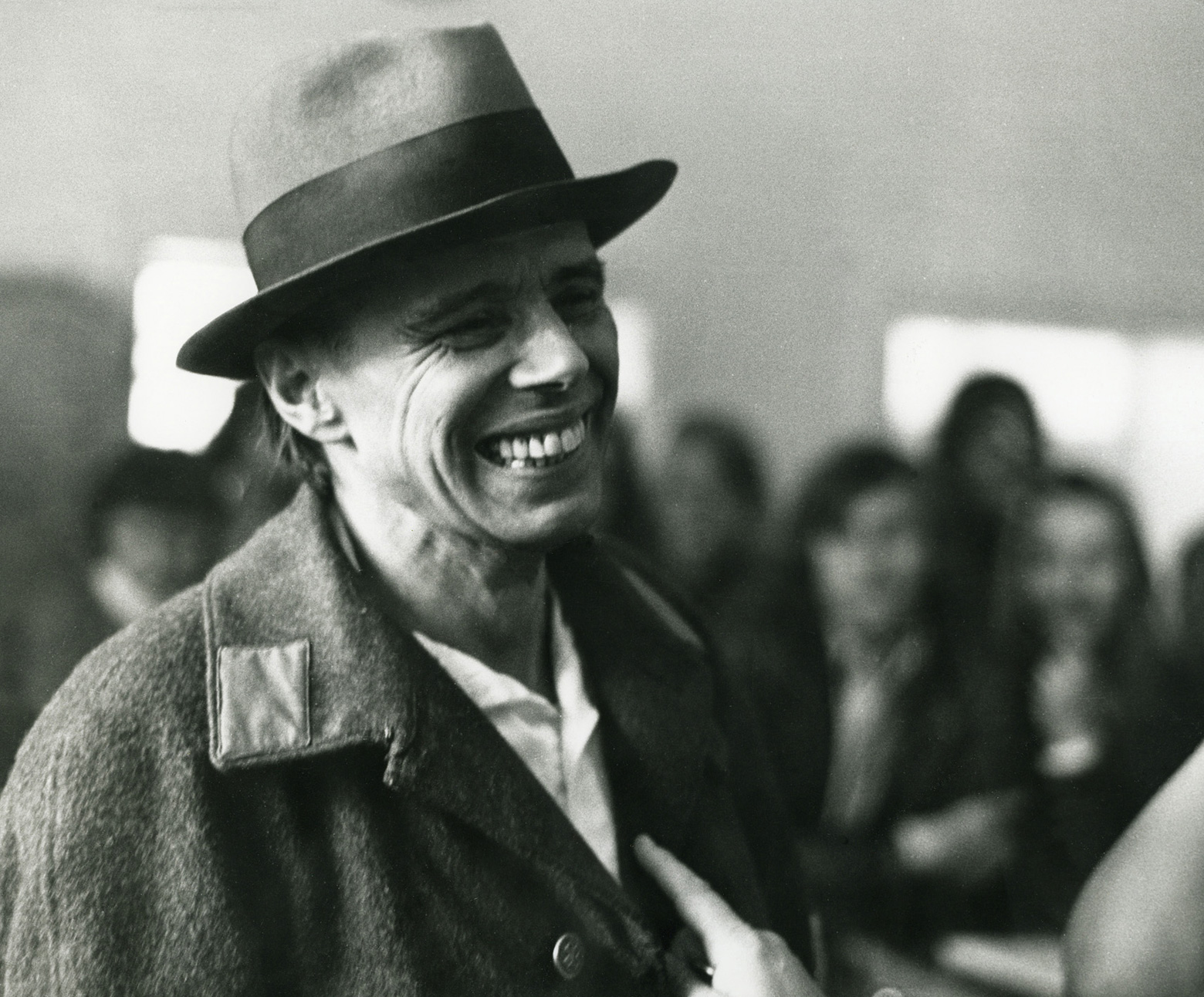A towering creative figure, whose work remains the subject of intense, often heated debate, the impact of Joseph Beuys on the art world of the past fifty years would be difficult to overstate.
Beuys was born in Krefeld in the German Rhineland in 1921, but was raised in the nearby town of Kleve, a short distance from the Dutch border. During the Second World War he trained as a radio operator in fighter planes.1 After being shot down in Crimea in 1944, he suffered major injuries, which would impact his health for the remainder of his life.
Following the war, Beuys took his first concrete steps toward becoming an artist. Enrolling at the Düsseldorf State Art Academy, from 1947–1953 he studied with the sculptor Ewald Mataré, a prominent German artist, well-known for his animal figures and religious commissions.
An important catalyst for this transition were the teachings of Rudolf Steiner.3 Concerned to counter what he saw as the excessive materialism of modern society, in which rationality had become the leading mode of experience, Steiner sought to reawaken what he termed humanity’s more ‘spiritual’ faculties, such as imagination, inspiration and intuition. In this way he hoped to rebalance social life and contribute to a broader process of human evolution.4 As a practice in which intuition, imagination and inspiration are of paramount significance, art, Steiner argued, could assume a leading role in this endeavour.5 Aligning himself with this position, Beuys would come to see himself as an advocate for spiritual development, a conviction he would never relinquish.6
In 1961, Beuys succeeded Sepp Mages as Professor of Monumental Sculpture at the Düsseldorf Academy and in the decade that followed would rise rapidly to prominence in the German art world. Encouraged by the emergence of the Fluxus movement, Beuys entered the arena of performance art, creating enigmatic, ritualistic ‘Kunstaktionen’ [art actions] in which he manipulated props that he had fashioned from a range of unorthodox materials, including copper, fat, felt and honey.

“Art in my opinion is the only evolutionary power. This means that only through man’s [sic] creativity can circumstances change. And I believe that many people feel that humanism can best be developed through art.”
For the most thorough account of Beuys’s life until World War Two, see H.P. Riegel, Beuys. Die Biographie (Berlin: Aufbau-Verlag, 2013), 9–64. ↩
On Beuys’s studies with Mataré and response to Mataré’s work, see H. P. Riegel, Beuys. Die Biographie (Berlin: Aufbau-Verlag, 2013), 91–99; and Heiner Stachelhaus, Joseph Beuys (Düsseldorf; Wien; New York: Icon Verlag, 1991), 31–42. ↩
On Beuys’s relationship to Rudolf Steiner, see Verena Kuni, Der Künstler als ‘Magier’ und ‘Alchemist’ im Spannungsfeld von Produktion und Rezeption Aspekte der Auseinandersetzung mit okkulten Traditionen in der europäischen Kunstgeschichte nach 1945. Eine vergleichende Fokusstudie – ausgehend von Joseph Beuys, unpublished doctoral dissertation, Philipps-Universität Marburg, 2004, 185–196; H. P. Riegel, Beuys. Die Biographie, 100–110,124–132 and passim; and John F. Moffitt, Occultism in Avant-Garde Art: The Case of Joseph Beuys (Ann Arbor: UMI Research Press, 1988), ch.s 5 and 6. ↩
For two of Steiner’s own introductions to his teachings and his concept of human spiritual evolution, see: Rudolf Steiner, Theosophy. An introduction to the Supersensible Knowledge of the World and the Destination of Man, http://wn.rsarchive.org/Books/GA009/English/AP1971/GA009_index.html; Rudolf Steiner, Knowledge of the Higher Worlds And Its Attainment, http://wn.rsarchive.org/Books/GA010/English/AP1947/GA010_index.html. Accessed April 20th, 2014. ↩
Steiner devoted a series of lectures to the arts in 1923, in which he put forward this idea. These talks were subsequently published as The Arts and Their Mission, http://wn.rsarchive.org/Lectures/GA276/English/AP1964/ArtMis_index.html. Accessed April 20th, 2014. ↩
As Beuys noted in this connection in a 1972 discussion:
“Art in my opinion is the only evolutionary power. This means that only through man’s [sic] creativity can circumstances change. And I believe that many people feel that humanism can best be developed through art.”
(Cited in Werner Krüger, ‘Beuys: Mein Kampf ist eine Plastik. Trotz Rausschmiß und Lehrverbot will er hart bleiben,’ Kölner Stadt-Anzeiger, October 19th, 1972; reprinted and translated in Götz Adriani, Winfried Konnertz and Karin Thomas, trans. Patricia Leach, Joseph Beuys. Life and Works (New York: Barron’s, 1979), 255.) ↩Among the most vivid of these gestures was the action wie man dem toten Hasen die Bilder erklärt (1965), in which Beuys whispered incomprehensibly to a dead hare cradled in his arms, while parading it before a group of nearby pictures. He would later describe this activity as an attempt to demonstrate the limited capacities of reason, especially in relationship to art:
“The idea of explaining to an animal conveys a sense of the secrecy of the world and of existence that appeals to the imagination. Then, as I said, even a dead animal preserves more powers of intuition than some human beings with their stubborn rationality.”
(Cited in Caroline Tisdall, Joseph Beuys (London: Thames & Hudson, 1979), 105.) ↩For comments by Beuys on art’s capacity to serve as a source of healing or therapy, see, for example: Joseph Beuys (New York: DIA Art Foundation, 1987), 18; and ‘Extracts from a Discussion with Joseph Beuys,’ in Axel Hinrich Murken, Beuys und die Medizin (Münster: Coppenrath, 1979), 152. On Beuys’s interest in adopting the role of the shaman, in a bid to provide a conduit between the visible realm of matter and the invisible domain of spirit, see Murken, ibid., 131–132; ‘Joseph Beuys im Gespräch mit Caroline Tisdall, 1974,’ in Secret Block for a Secret Person in Ireland (Tübingen: Kunsthalle Tübingen, 1988), 49; and Joseph Beuys. Schamane (Nürnberg: Verlag für Moderne Kunst, 2008), 2. ↩